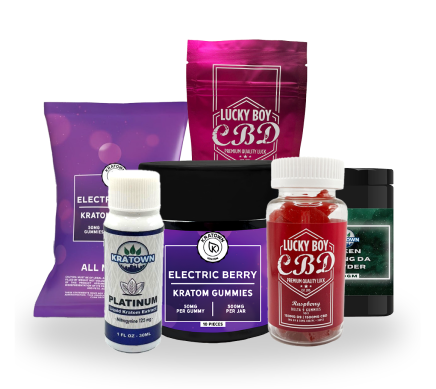
Kratom: What It Is and How It Works
Have you ever heard of kratom? No, not the place where Superman was born. Kratom. It’s a tree with leaves that are said to have stimulant and sedative effects.
Today, we’ll need to put on our reporter hats and ask some of the basic questions many people have about kratom to get to know it better.
Where Does Kratom Come From?
Kratom is the common, much easier-to-pronounce name given to the Mitragyna speciosa Korth tree. But for simplicity’s sake—and to keep your tongue untwisted—we’ll call it the kratom tree.
It’s a type of tropical evergreen tree native to Southeast Asia that grows mostly in countries like Indonesia, Malaysia, and Thailand. But recently, folks in other places around the world with similar, suitable climates, like Hawaii and Ghana, have also been experimenting with cultivating them.
The kratom tree typically reaches a height of around 50 feet but can grow as tall as 80 feet. The kratom that consumers use doesn’t come from the tree's roots or bark but rather from its large, dark green, glossy leaves.
What is Kratom Made Up Of?
It’s time to look into the science behind kratom a little bit. But don’t worry—we won’t make this feel like a painful flashback to high school chemistry.
The active ingredients in kratom are known as alkaloids, which can act as stimulants or sedatives depending on their intensity. Kratom’s two main alkaloids are mitragynine and 7-hydroxymitragynine—quite a mouthful. Mitragynine is a compound first isolated in 1921, and it’s most abundant in the leaves of the kratom tree. 7-hydroxymitragynine is the other main component, but only small amounts of this compound exist in kratom leaves.
Basically, these alkaloids interact with the receptors in the brain called the opioid receptors, which are the ones involved in pain relief, mood regulation, and pleasure.
How Can Kratom Be Used?
Kratom producers harvest the leaves by hand from mature trees, which typically contain more of those active components. Individuals who want the kratom benefits can use the leaves in several forms, including:
- Fresh Leaves: Those kratom users who prefer fresh leaves typically chew a few leaves at a time. But fresh kratom leaves are extremely bitter to the taste.
- Dried Leaves: When dried, kratom leaves are consumed directly or sometimes brewed into a concentrated tea.
- Powder: Kratom producers make a powder from dried and ground kratom leaves. It is very versatile, and kratom users often buy kratom powder to mix it with beverages like water, juice, or smoothies.
- Capsules: Kratom sellers can encapsulate the kratom powder, which helps with easy dosing. Capsules also make the kratom tasteless, helping users avoid the raw stuff’s bitterness.
- Extracts: These are concentrated forms of kratom, which are usually much more potent and require smaller doses.
- Gummies: Flavored kratom gummies are a newer form that combines the extract with gelatin and flavorings, making them a tastier option for consumers.
The form of kratom a person chooses often depends on their preferences since each form has its own strength and onset time.
Why Do People Use Kratom?
Kratom leaves have been harvested and used for hundreds of years for multiple purposes.
We often hear of customers using kratom for chronic pain relief. Many consumers from the elderly population who have joint aches say that kratom helps with soothing. Others mention that kratom helps with pain from migraines and fibromyalgia.
Users also note that they feel that kratom has increased their mental stimulation, helping them to be more focused and alert. They say that it improves their productivity and efficiency while studying or working on a challenging task.
And with that, other people call kratom an energy booster like caffeine but without the typical side effects you get from your morning cup of joe, like fatigue, jitters, or nervousness.
What Should I Consider Before Using Kratom?
Before you put something into your body, whether that’s food, beverages, or anything else, it’s important to consider what is appropriate for you, particularly if you have pre-existing health conditions.
Inform yourself of a product’s purpose of use and potential side effects. Some consumers have reported side effects of kratom, such as nausea, dizziness, and a dry mouth.
If you’re taking a prescription medication, make sure you know how anything else you ingest will interact with it. Not sure if kratom will affect your medications? There’s an easy solution—just ask your doctor.
It might be common sense, but buying any goods, including kratom, from reputable sources helps you avoid contaminated or otherwise harmful products.
The Final Word
So, there you have it—kratom in a nutshell (or rather, a leaf). So maybe you’re sipping it in tea or popping it in capsules, but there’s no getting around the fact that kratom has made its way into the spotlight.
You can purchase kratom in a variety of its many forms from online retailers, local herbal stores, and some convenience stores or farmers’ markets.
If you decide to try out kratom, just remember that you may experience its bitter taste before its benefits kick in.
Video
Infographic
Kratom producers hand-harvest leaves from mature trees, which typically contain more active components. Individuals seeking the benefits of kratom can use the leaves in several forms; learn more in this infographic.

Disclaimer: The information in this article is for educational purposes only and is not medical advice. Kratom use may carry potential risks, and its legality varies by location.

